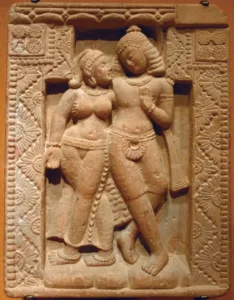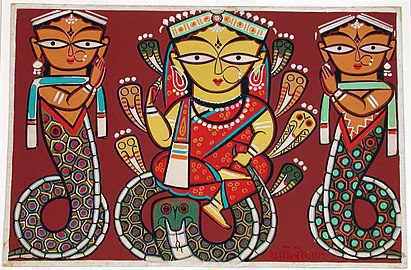

The term “craft” is derived from the Middle English word “strength” or “skill,” which is derived from the Old English word “craeft,” which is derived from the Old High German word “kraft,” which is for strength, and denotes “skill in planning, making, and executing,” as well as “an occupation or trade requiring skill,” with crafts being those things made using that skill (Merriam-Webster Dictionary). Every civilization and culture has created its own crafts, and the phrase may be used to describe many different facets of every single one of them. India has a diverse crafts industry that is rich in history, culture, and religion. Each state in India has a unique craft that shows the impact of various empires that have ruled the subcontinent . Apart from this arts and crafts have been ingrained as a culture and custom in the rural areas since ages.The history of Indian handicrafts is an old saga. The rich craft traditions of the past are largely responsible for the current state of craft in India. Because of its practicality, accessibility to the general public, and demand in both local and international markets, the majority of historical crafts are still in high demand today. The unique requirements of the clients and the social elites , along with a keen awareness of both internal and international trade, became the focus of Indian handicrafts. Due to the way Indian culture is absorbing, it is still flourishing today.

Crafts of Ancient Period
The ruins of the Indus Valley Civilization include the earliest references to Indian crafts (3000 B.C.-1700 B.C.). There was a strong artisan culture in the Indus valley civilization. It mainly excelled in the fields of pottery, jewellery, threading, and different sculptures made of metal, stone, terracotta, etc., . Many physical relics discovered during excavations at Harappa, Mohen-jo-daro, and other sites support the Indus valley civilization’s craft heritage. The artisans met the locals’ basic requirements and exported extra goods, mostly by travel, to ancient Arabian nations. The Vedic era, which began around 1500 B.C., brilliantly absorbed the rich legacy of the Indus Valley Civilization. The Vedic literature is replete with examples of artisans engaged in woodworking, weaving, pottery production, and other crafts . The Rig Veda, in particular, makes reference to various pottery composed of clay, wood, and metal. It also includes information on the several weavers and weaving practises of that period.

Crafts of Medieval Period
The Maurya Period : Beginning in the third century B.C., the artistic production of crafts also flourished during the Mauryan Empire, a turning point in Indian history. There are estimates that 84,000 stupas were built in India under the reign of Ashoka. It has the “Sanchi stupa,” which is renowned across the world for its exquisite stone carving and relief work. It was also popular to wear jewellery at that period . This is demonstrated by a number of sculptures that were discovered in the provinces of Bharhut, Mathura, Amravati, Vaishali, and Sanchi showing female figures adorned in lovely jewels. At the height of Emperor Ashoka’s reign the metallurgical prowess of that period are depicted in the iron pillars of Vaishali and Delhi.

The Buddhist and Gupta Period: The foreign invaders ignoring their own cultural and tradition elevated India’s craft history. The time frame was between the first century B.C. to the first century A.D . The effects of these incursions can be seen in Buddhist sculptures from Taxila, Begram, Bamiyan, Swat Valley, etc. A significant amount of Greek influence may be seen, especially in the statue of the Buddha with its curled hair and drapes. The sculptures of the Kushana king Kanishka continue this trend. These date back to the same time period and show how central Asian culture influenced Indian workmanship. These inspirations were passed down and also assimilated into other beautiful artisan items, including as jewellery, textiles, leather goods, and metalworking, according to the Indian context. The Gupta era (AD 320–647) not only regarded as the classical era of Indian history, but also of the history of Indian crafts. Perfect examples include the Ajanta murals and the Ellora rock-cut temples. These wall murals provide us a clear picture of the way of life at the period. Another intriguing aspect is that it developed under the patronage of Gupta kings, becoming expert in weaving, sculpture, stone cutting, and the production of jewellery.

The Mughal Period: The artisans flourished in the fields of pottery, weaving, wood carving, metal works, jewellery, etc. during the Delhi Sultanate period. The Mughal era was the pinnacle of craftsmanship. The Mughals carried a vast tradition with them that they had assimilated from Persian lands. New skills including inlay work, glass engraving, carpet weaving, brocades, enamelling, etc. were transmitted. The traditions of numerous Indian schools of painting, like Rajasthani, Kangra, Pahari, etc., had an impact on the Mughal miniature paintings as well. One of the finest examples of precious stone ornamental work and metal artistry is the famed Peacock Throne of the Mughals. They also established the framework for a wide range of craft customs, including the renowned Mughal miniature painting. A special instance of inlay work is petra dura, which is exquisitely adorned with jewellery.

The Legacy of South India: Indian history’s Middle Ages are important in terms of the evolution of crafts. After gaining control of the market for the entirety of India’s northern territory, it spread its influence to the southern region. The Vijaynagar Empire and the Cholas made unparalleled contributions to bronze sculpting, silk weaving, jewellery, and temple carving. The Khajuraho Temples, constructed by the Chandelas, are a remarkable example of central Indian stone carving. The ancient Jagannath temple in Puri, Odisha, has such elaborate wood and stone carvings. Dravidian style, stone carved temples reflect the influence of Hinduism whilst Roman Catholic churches echo the impact of the British rule. Temple carvings are symbolic of the craft skills in the Tamil Nadu region. The Meenakshi temple of Madurai typifies the skills and devotion put into this craftwork.

Crafts of Modern Period
Indian crafts have grown and developed significantly in the modern world. Each and every Indian state has its own own culture, as is evident in the Sholapith from West Bengal, a handicraft from that region. Each state also has its own designs, colours, materials used, and distinctive shapes and patterns. For instance, Kashmir is well-known for its carpets, jewellery, ivory crafts, and shawls made of Pashmina wool. Assam and West Bengal, two North-Eastern and Eastern states, are well known for their beautiful “Sholapith” and “Shital Patti” works. Other areas, such as Karnataka, are well known for their handicrafts, such as those made of sandalwood and rosewood carvings.

Some of the exclusive crafts that have gained popularity outside of India are the engraved and enamelled meenakari brassware from Rajasthan, silk products from Varanasi and Kanchipuram, vibrant embroidery, mirror work, quilting, and fabric painting from Gujarat, and many others.A few places are well known for their crystals and semi-precious stones, and trendy stone crafts . A few examples of contemporary crafts include bed linens, tablecloths, napkins, and home furniture. These examples of textile art, which use a variety of masterful printing techniques like hand, block, and tie-dye printing, are quite popular right now.


Popular Crafts of Modern India
Numerous utilitarian craft products, including bedcovers, sheets, cushions, curtains, tablecloths, bags, metal furniture, mats, boxes, cabinets, wood furniture, toys, utensils, garden pots, terracotta items, brass and silverware, leather products, papier-mâché products, cane, jute, and coir items, carpets, rugs, durries, etc., have a large domestic market. Craft goods are created with a contemporary style, taking into account of current fashion demands. The majority of the organizations making crafts for everyday use have become small-scale businesses.
The demand for decorative items like traditional wall hangings, silver cutlery, brass pots, embellished wooden sculptures, marble and wood inlay work, silk carpets, wrought iron furniture and decorative items, traditional paintings, enamelled furniture, stone and wood carvings, metal, wood, and stone sculptures, etc., is increasing both in India and abroad thanks to the market for art and craft. The largest export-focused Indian craft business is carpet weaving. Costly Kashmiri silk carpets are in high demand because they have evolved into status symbols in traditional Indian houses. Additionally, the luxurious woollen and non-woolen carpets attract contemporary shoppers and art enthusiasts. Today’s shops are overrun with flooring options, and Indian houses’ floors are decorated with a wide range of traditional durries.

The value of Indian crafts has endured through the ages, and the fact that they are still in use today is a testament to the efforts made for their preservationIndia’s enormous diversity of handicrafts produced all around the nation reflects its rich cultural past and centuries of evolving tradition. Crafts are a reflection of the ethnic group who makes them and its cultural identity. Indian handicrafts have kept their exclusivity throughout the ages, such as the Kashmiri woollen carpets, Zari embroidered fabrics, terracotta and pottery goods, silk fabrics, etc. These handicrafts were once shipped along the “silk route” to distant nations in Europe, Africa, West Asia, and the Far East. The vast majority of India’s timeless handicrafts have endured through the years. The exotic allure of Indian culture, which promises exclusivity, beauty, dignity, and elegance, permeates these crafts.